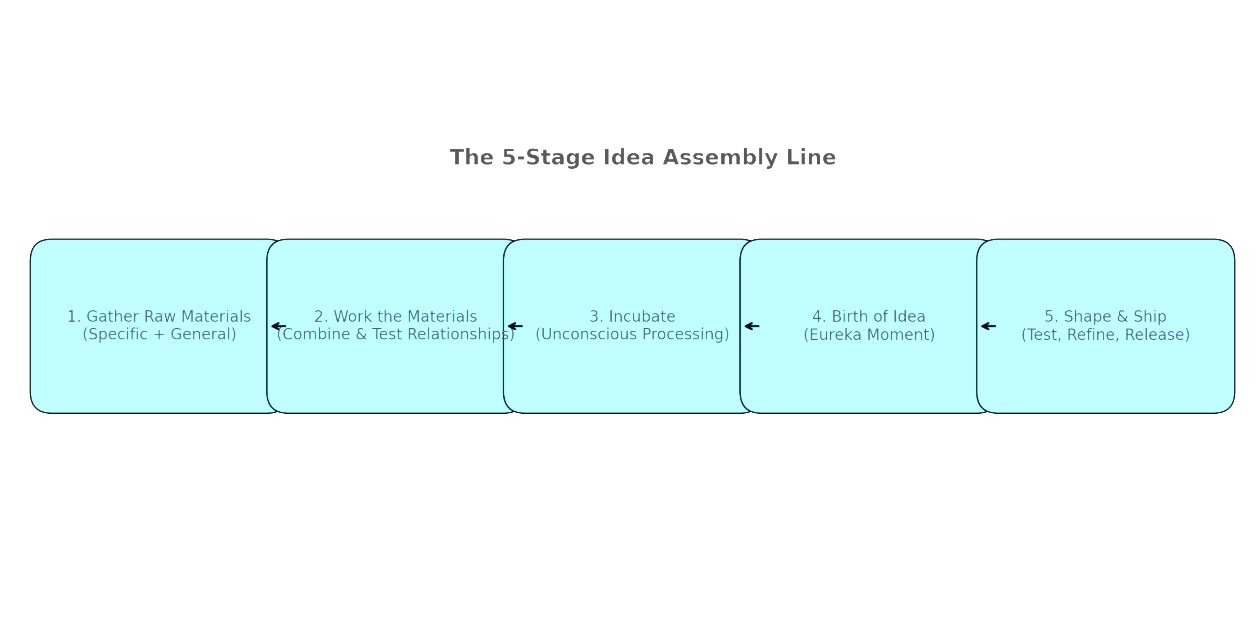Based on James Webb Young’s A Technique for Producing Ideas — adapted for IMMachines
Core premise: An idea is a new combination of old elements.
The production of ideas is a definite process you can learn, run, and improve—like an assembly line.
If you’ve ever thought “I’m not creative,” here’s your permission slip: creativity is less lightning bolt and more workflow.
James Webb Young gives us a five-stage line that turns raw inputs into shippable ideas. Below is a clean, step-by-step version for modern creators—complete with quick actions, small rules, and IMMachines GPT assists so you can run this in 60–90 minutes a day.
Overview: The 5-Stage Idea Assembly Line
-
Gather Raw Materials (specific + general)
-
Work the Materials (conscious combination)
-
Incubate (hand off to the unconscious)
-
Birth (capture the “aha”)
-
Shape & Ship (test, refine, release)
Golden rule: Do not skip stages. Each one primes the next.
Stage 1 — Gather Raw Materials (15–30 min/day)
What it is:
You stock two bins so your later combinations aren’t thin soup.
A) Specific materials (today’s problem)
Facts about your product, audience, channel, constraints, outcomes. Get so specific you can see what’s unique about the relationship between your offer and your people.
Do this now
-
Create two “bins” in Notion/Docs/Drive:
-
01_Specific(screenshots, objections, testimonials, features, metrics) -
02_General(articles, quotes, observations, stories, odd facts)
-
-
Use Idea Cards (Young’s card-index, modernised):
-
Add 5–10 cards per day. That’s it.
B) General materials (your lifelong pantry)
Seemingly random knowledge you keep browsing: history, science, nature, film, craft notes, spiritual insights, jokes. This widens your “combination universe.”
IMMachines assist
-
Prompt Builder Pro: “Summarize these screenshots/notes into Idea Cards with ‘Why it matters’ and suggested tags.”
-
From Chaos to Clarity: “What specific gaps in audience knowledge should I research next?”
Small rule: Capture first, classify later. Collection > perfection.
Stage 2 — Work the Materials (20–30 min)
What it is:
Conscious play. Turn facts over, mash them together, look for relationships. Expect rough, partial ideas.
Do this now
-
Make a Combo Grid: place 10 specific cards down the left, 10 general cards across the top. Force 10–20 quick mashups.
-
Write partial ideas immediately (bad and good).
-
Keep going until you hit the “hopeless stage” (it feels like spaghetti). That’s your signal you’ve done enough conscious chewing.
IMMachines assist
-
Thought-Leader Engine: “Create a relationship matrix between these 20 cards. Surface 10 surprising combinations with 1-sentence rationales.”
-
Prompt Builder Pro: “Generate 15 ‘X meets Y’ angles. Label which audience emotion each angle evokes.”
Small rule: Quantity before cleverness. You’re building parts, not picking winners yet.
Stage 3 — Incubate (4–24 hours)
What it is:
Stop “trying.” Turn the problem over to your unconscious. Let it synthesize.
Do this now
-
Drop it completely. Close tabs. No peeking.
-
Stimulate imagination: walk without headphones, take a shower, light music, short story/poem, light film.
-
Prime before sleep: write one clean question:
“How might [element A] and [element B] meet to solve [audience tension]?” -
Schedule return time so this isn’t avoidance.
IMMachines assist
-
From Chaos to Clarity: “Create a 3-bullet incubation brief and tomorrow’s 30-minute re-entry checklist.”
Small rule: Incubation is a task, not a nap. Give the back-of-house time to cook.
Stage 4 — Birth (capture the “Eureka”)
What it is:
The idea pops up when you’re not forcing it—often in the morning, shower, commute.
Do this now
-
Keep a capture kit handy: phone voice memo, bedside card, tiny notes app.
-
Record the idea as is—headline + 3 bullets. Don’t start editing.
IMMachines assist
-
Thought-Leader Engine: “Turn this raw idea into a 150–300 word concept note: promise, tension it resolves, core mechanism, one metaphor.”
Small rule: Catch first, polish later. Don’t scare the deer.
Stage 5 — Shape & Ship (30–60 min)
What it is:
Reality check. Adapt the new-born idea to constraints; test it; invite clean criticism.
Do this now
-
Build an MVM (Minimum Viable Magic):
-
Promise (≤18 words)
-
Process (3 steps)
-
Proof (1 tiny example)
-
CTA (1 line, no hype)
-
-
Share with a small judicious panel (2–5 people who’ll tell you the truth).
-
Tighten language, fix edges, and ship a micro-artifact (post, 1-pager, 90-sec video, prompt stack).
IMMachines assist
-
Copy Pro Engine + Sales Angle Generator: headlines, subheads, body, CTA in your voice.
-
Business Problem Solver GPT: “Run a quick ‘5 Whys’ on the weakest link in this idea.”
-
Navigator → Traffic Method Navigator / Free or Paid Traffic Engine: pick the fastest channel to get signal in 48 hours.
Small rule: Ship small and soon. Great ideas get stronger in public.
Run It as a Weekly Routine
Mon — Stage 1 (Gather) 30 min + Stage 2 (Work) 30 min
Tue — Stage 2 (Work) 20 min + Stage 3 (Start Incubation)
Wed — Stage 3 (Incubate) (no touching)
Thu — Stage 4 (Capture) 10 min + Stage 5 (Shape & Ship) 45–60 min
Fri — Collect feedback, log learnings, decide next test
Sat/Sun — Light browse for general materials (15–20 min)
Creative SLA suggestion: “No idea sits untested longer than 7 days.”
What “Good” Looks Like (Signals to Track)
-
Language echo: People repeat your phrasing back to you.
-
Micro-pull: Unprompted DMs asking “Can I try this?”
-
Frictions revealed: A step is confusing → you tighten it.
-
Self-expanding: Others add improvements you missed (don’t cling—document and adopt).
Log all of this in a simple Idea Log: date, promise, test artifact, signal, next step.
Pitfalls & Fixes
-
Skipping Stage 1 (thin pantry): Fix: 10 Idea Cards/day.
-
Overworking Stage 2 (analysis trap): Fix: stop at “hopeless stage,” move to incubation.
-
Fake incubation (still doom-scrolling): Fix: schedule offline activity + prime question.
-
Falling in love with first draft: Fix: MVM + panel feedback in 24–48h.
-
Boiling the ocean at Stage 5: Fix: ship the smallest true thing first.
One-Page Cheat Sheet (copy/paste)
Idea Card
MVM
Incubation Prime
Why This Serves Mid-Life Creators
You’ve already collected decades of “old elements.” This system turns that life capital into repeatable originality without burning you out. It respects constraints, honours intuition, and produces results on a calm cadence. Pace over panic. Craft over chaos.
And yes, it feels a little magical when ideas “arrive” on schedule. That’s not luck; that’s a well-run line.
IMMachines: Quick Prompts to Automate the Line
-
Prompt Builder Pro:
“Turn these notes into 10 Idea Cards with tags and ‘why it matters’ from the buyer’s POV.” -
Thought-Leader Engine:
“Create 10 relationship combos from these cards; explain each in one sentence; rank by novelty × usefulness.” -
From Chaos to Clarity:
“Produce a 3-bullet incubation brief and a 30-minute re-entry checklist for tomorrow.” -
Copy Pro Engine:
“Draft a one-page MVM (headline, sub, 3 steps, example, CTA) in my voice—clear, calm, no hype.” -
Business Problem Solver GPT:
“Run 5 Whys on this idea’s weakest step and propose one 24-hour fix.” -
Navigator / Traffic Engines:
“Choose the fastest channel to get meaningful feedback from my current audience in 48 hours. Build a 7-day micro-plan.”






